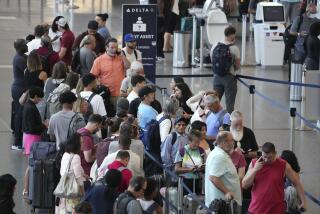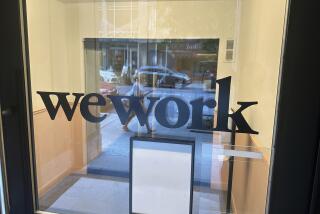Continental Airlines Again Puts Itself in Bankruptcy : Travel: High fuel costs cited. The firm says it will maintain full service. More air carrier failures seen.
NEW YORK — For the second time in seven years, Continental Airlines filed for bankruptcy protection Monday, saying that extraordinarily high fuel costs had made it impossible to pay down debts piled up largely in an airline-buying binge in the 1980s.
The Houston-based carrier, the nation’s fifth largest, became the first airline to take such action in what analysts and economists predict will be a spate of liquidations and bankruptcies long developing but finally triggered by fuel price rises caused by the crisis in the Middle East.
“One could say that the last chapters are being written about some of the U.S. airlines that are weakening,” said Dr. Frank Spencer of the Northwestern University Transportation Center.
In its court filings, Continental listed debts of more than $2.2 billion, part of a total of $5.9 billion in liabilities. Its biggest creditors are Ameritrust of Texas, General Electric Co., Douglas Aircraft Co. and Boeing Corp. Continental valued its assets at $4.8 billion.
Hollis Harris, Continental’s chairman and chief executive, said the airline plans to continue business as usual while it reorganizes its debt. Continental’s parent, Continental Airlines Holdings Inc., and a number of its other subsidiaries--including Air Micronesia, which operates in the Pacific--were included in the bankruptcy filing.
“Continental will continue a full flight schedule,” Harris told a news conference Monday in Wilmington, Del., where Continental is incorporated and where the airline filed for bankruptcy. “All of our 37,000 employees will remain on the job at full salary and full benefits to ensure that our customers continue to receive the full level of service they expect.”
Harris--who took charge of Continental in September, when controversial financier Frank Lorenzo resigned--added that all arrangements with travel agents remain in effect, as does the airline’s frequent flyer program. Fares will not be affected, he said.
If Continental is able to operate unimpaired, Harris, formerly president of Delta Air Lines, will have undertaken a very different kind of bankruptcy from the one Lorenzo took Continental into on Sept. 24, 1983.
The airline’s machinists had gone on strike a month earlier, and Lorenzo set out to abrogate Continental’s union contracts.
He was successful, giving Continental labor costs that today are 10% to 20% lower than those of others in the industry and prompting Congress to amend the nation’s bankruptcy law to make it harder to get out from under labor agreements. Lorenzo became a pariah to organized labor.
After the 1983 bankruptcy, Continental was grounded for several days and did not return to normal operations for about six months. It emerged from bankruptcy only after three years of financial and legal skirmishing.
Similarly, another Continental subsidiary, Eastern Airlines, was shut down for a time when it filed for reorganization nearly two years ago. Eastern still is in Chapter 11 and has never returned to normal operations.
Harris said on Monday that he did not know how long it would take Continental to escape the courts this time, but he indicated that the reorganization would be much quicker.
“It’s a new way to file for Chapter 11,” said Rose Ann Tortora, airline analyst with County NatWest USA, the American branch of a British investment house. “Usually, you lay off people, cut salaries, strand passengers. There has not been one stranded passenger yet. It is clear that Continental did this to protect itself from its cash flow problems.”
Ray Valeika, senior vice president of operations, was somewhat less sanguine about the airline’s prospect during a meeting with Continental employees Monday in Los Angeles.
A group of several hundred mechanics and other technical workers listened in silence as Valeika said the bankruptcy filing would “buy us some time” but not put future layoffs out of the question.
“I’m definitely going to start looking for a job,” said avionics technician Nizar Jazzar. “I’m concerned for my family.”
Continental, which serves 150 cities and provides service to 58 international destinations, flies 98,000 passengers on an average day. It has $5 billion in annual revenues and is the third largest U.S. carrier in the Pacific, behind Northwest Airlines and United Airlines.
Airline analysts have been warning that the skyrocketing price of jet fuel would begin to knock out some of the nation’s weaker carriers. And it was fuel prices that Harris cited in announcing Continental’s moves.
He complained that Continental had paid 57 cents a gallon for fuel before Iraq invaded Kuwait in August--a price that rose as high as $1.28 before settling now to $1.06 a gallon.
The result, Harris said, was that Continental has been paying as much as $70 million a month extra for fuel, resulting in a “cash flow erosion of $500 million--money we would have had if there had been no invasion.”
One bankruptcy specialist said that the filing was a smart move by the ailing airline, allowing Continental to shift sorely needed cash away from paying off old debts to paying for operations.
“This is probably a viable strategy,” said Richard A. D’Aveni, a professor at the Amos Tuck School of Business at Dartmouth College.
One reason Continental is so highly leveraged is that Lorenzo borrowed heavily to finance his purchases of Eastern in 1986 and People Express a year later.
“It is not just fuel,” said Timothy Pettee, airline analyst with Alliance Group, a mutual fund company. “It is the debt structure acquired in those two acquisitions.”
Lorenzo meshed the two airlines into Texas Air Corp., which this year changed its name to Continental Airlines Holdings Inc. Also, he acquired Frontier Airlines and established New York Air.
Harris said the decision to seek court protection received unanimous support from the company’s board, whose members include Lorenzo. SAS Corp., the Scandinavian airline company, owns 16.8% of Continental and has three members on the board, including SAS President Jan Carlzon.
“It is extremely regrettable that the gulf crisis came up just when Continental was making good progress,” Carlzon said in a statement. “Even if the situation is serious, Continental has a good opportunity to recover from its situation in a stronger position.”
The Chapter 11 filing complicates the already confused picture at Eastern.
Continental has been held liable for large payments owed to Eastern’s pension fund. And, although observers say Continental will now attempt to free itself from that liability, the government-owned agency that insures pension funds said Monday that it would try to recover $700 million from Continental Holdings.
To help solve immediate cash flow problems, Continental announced that it had agreed to sell its route authority from Seattle to Tokyo to American Airlines for $150 million. Continental will continue to operate the route through most of next year, and American will soon make an advance payment of $140 million toward the purchase.
Staff writer Marc Lacey in Los Angeles contributed to this story.
CONTINENTAL’S BANKRUPTCY FILINGS
Continental filed for bankruptcy protection in 1983, citing declining passenger traffic and high labor costs. Monday’s Chapter 11 filing, according to the airline, was brought about by high fuel costs and a high debt load, which has caused a cash shortage. Listed below is a comparison of figures from Contintental’s annual reports for the respective years that preceded the two bankruptcy moves.
1982 1989 Revenue: (in billions of dollars) $1.40 $4.80 Revenue Passenger Miles (in billions of miles) Domestic Traffic: 8.26 28.43 International Traffic: 1.62 10.35 Employees: 14,500 33,600 Fleet: (number of planes) 105 325
Sources: ESG Aviation Services, Avmark, Continental Airlines
PARENT COMPANY AT A GLANCE
Formerly Texas Air Corp., Continental Airlines Holding owns a number of subsidiary airlines, including Eastern, which filed for bankruptcy in March, 1989. Scandinavian Airlines (SAS) increased its ownership in Continental to 16.8% last August.
1989 1988 1987 Revenue in millions: $6,685 $8,573 $8,475 Net income (loss): ($886) ($719) ($466)
Number of employees: 37,000
Number of common shares outstanding: 42.5 million
12-month stock price range: $13.75 - $2.25
Source: Standard & Poor’s
More to Read
Inside the business of entertainment
The Wide Shot brings you news, analysis and insights on everything from streaming wars to production — and what it all means for the future.
You may occasionally receive promotional content from the Los Angeles Times.










